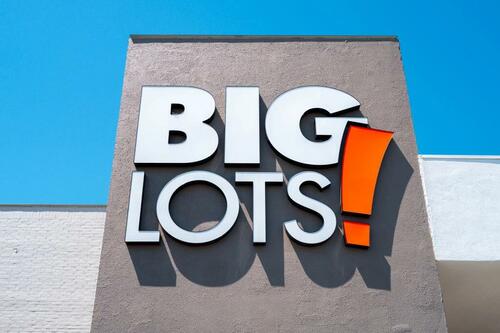Bankrupt Big Lots Strikes Sales Deal, Preserves Brand Name
Authored by Naveen Athrappully via The Epoch Times,
Big Lots finalized a deal that preserved the brand name and prevented the discount retail chain from entirely going under.
Ohio-based Big Lots announced it filed for Chapter 11 bankruptcy earlier this year, citing economic pressures. The company tried to sell its business to Nexus Capital Management but failed to strike a deal. On Dec. 27, Big Lots announced a sales transaction with Gordon Brothers Retail Partners.
As part of the agreement, North Carolina-based Variety Wholesalers will acquire around 200 to 400 Big Lots stores “which it plans to operate under the Big Lots brand.”
Variety, which owns more than 400 retail stores in the Southeast and Mid-Atlantic United States, may also “employ Big Lots associates at the acquired stores and distribution centers, as well as certain corporate associates.”
Bruce Thorn, chief executive officer of Big Lots, said the sale to Gordon Brothers and transfer to Variety is a “favorable and significant achievement.”
“This sale agreement and transfer present the strongest opportunity to preserve jobs, maximize value for the estate, and ensure continuity of the Big Lots brand,” he said.
The agreement now needs to be approved by the bankruptcy court and must undergo other closing conditions.
Big Lots operates more than 1,400 stores across 48 states in the United States. While filing for bankruptcy, the company cited issues like inflation, saying that rising prices have changed the spending behaviors of customers.
“The prevailing economic trends have been particularly challenging to Big Lots, as its core customers curbed their discretionary spending on the home and seasonal product categories that represent a significant portion of the company’s revenue,” it said in September.
Big Lots listed assets and liabilities in the range of $1 billion to $10 billion, owing money to 5,001 to 10,000 creditors. The company’s shares have crashed by more than 99 percent this year.
Last week, the company said it intends to kick off a “going out of business” sale at its stores.
Bankruptcies on the Rise
Multiple American retail chains have entered bankruptcy over the past year. In June, apparel retailer Bob’s Stores went bankrupt and decided to sell all its stores in Connecticut, Massachusetts, New Hampshire, New Jersey, New York, and Rhode Island.
In July, furniture retailer Conn’s announced filing for bankruptcy, closing down all its 553 stores nationwide following a sales slowdown over past years.
New Jersey-based Party City filed for Chapter 11 bankruptcy in December, and said it was preparing to close down almost 700 stores across the country. This was the second time in two years that the company filed for bankruptcy.
According to an S&P report, there have been 634 U.S. corporate bankruptcy filings in 2024, up to the end of November, with the figure on track to potentially hit a new 14-year annual high. S&P bankruptcy numbers only take into account large companies that exceed certain asset and liability thresholds.
The jump in bankruptcies comes as businesses face challenges like inflation, elevated interest rates, and changing consumer spending patterns, it said.
“While the US Federal Reserve has begun lowering its benchmark interest rate from a 20-year high, the pace of further cuts may slow in 2025 amid challenges posed by persistent inflation and potential tariffs implemented by President-elect Donald Trump,” said the report.
“However, Trump’s election victory in November did provide an initial boost to stock markets and investor risk appetite.”
The American Bankruptcy Institute reveals that overall commercial bankruptcy filings fell 1 percent yearly in November, according to a Dec. 4 statement.
Michael Hunter, vice president of bankruptcy filing data provider Epiq AACER, attributed this small decline to fewer business days and the holiday season.
ABI Executive Director Amy Quackenboss said that “elevated interest rates, tougher lending terms, and increased geopolitical tensions continue to impact the balance sheets of many struggling businesses and families.”
“While still below the levels recorded prior to the pandemic, the steady growth in filings reflects the growing financial challenges faced by distressed companies and consumers.”


